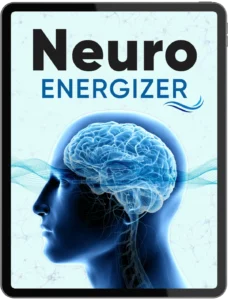In a world filled with distractions—social media notifications, endless to-do lists, and constant background noise—staying focused has become more difficult than ever. That’s why tools designed to boost concentration, such as brainwave entrainment audios, are growing in popularity. One of the most talked-about products in 2025 is NeuroEnergizer, a specially designed audio program that claims to improve focus, mental clarity, and productivity by tapping into the brain’s natural rhythms.
But does it actually work, or is it just another overhyped self-improvement tool? In this in-depth NeuroEnergizer Review 2025, we’ll break down what it is, how it works, the science behind it, potential benefits, drawbacks, and whether it’s worth trying.
What Is NeuroEnergizer?
NeuroEnergizer is an audio-based program that uses sound frequencies, ambient tones, and rhythmic pulses designed to help the brain enter states of enhanced concentration. Unlike traditional music playlists, NeuroEnergizer is built on the concept of brainwave entrainment—a method where auditory beats are used to synchronize the brain’s electrical activity, nudging it into a specific mental state.
According to its creators, listening to NeuroEnergizer for just 15–30 minutes per session can help you:
- Improve concentration and focus during study or work
- Boost mental energy without caffeine
- Enhance memory retention
- Reduce distractions and mental fatigue
- Enter a “flow state” more easily
How Does NeuroEnergizer Work?
The foundation of NeuroEnergizer lies in binaural beats and isochronic tones. Here’s how they function:
- Binaural beats: When you listen to slightly different frequencies in each ear through headphones, the brain perceives a third “phantom beat.” This encourages brainwave synchronization in specific ranges, such as beta (alertness) or gamma (high-level processing).
- Isochronic tones: These are single tones that pulse on and off at certain intervals. They are believed to directly stimulate brainwave patterns without requiring headphones.
By targeting specific frequencies associated with concentration, NeuroEnergizer attempts to shift your brain into an optimal cognitive state. For example, the beta range (13–30 Hz) is associated with focused attention, problem-solving, and active thinking, while gamma waves (30–100 Hz) are linked with peak mental performance and memory formation.
The Science Behind Audio-Based Focus Tools
Brainwave entrainment is not a new concept. Multiple studies over the past few decades have explored how sound frequencies can impact attention, relaxation, and even sleep quality. Research suggests:
- Binaural beats in the beta range may improve sustained attention and cognitive performance.
- Gamma entrainment could enhance memory and information processing.
- Auditory stimulation may reduce stress and mental fatigue, making it easier to focus for long periods.
However, the scientific community is still divided. While some studies show significant benefits, others suggest the placebo effect may play a role. In short: the evidence is promising, but not conclusive.
Key Features of NeuroEnergizer
What sets NeuroEnergizer apart from other brainwave audio programs? Here are some highlights:
- Multiple Focus Tracks – Designed for different purposes like studying, working, or creative thinking.
- Portable and Easy to Use – Works on any device (phone, laptop, tablet) with headphones or speakers.
- Short Sessions – 15 to 30 minutes per track, making it easy to fit into a daily routine.
- Non-Chemical Boost – No caffeine, stimulants, or supplements required.
- Backed by Neuro-Acoustic Engineering – Claimed to be developed using the latest brainwave entrainment research.
Benefits Reported by Users
Many 2025 users claim NeuroEnergizer helps them achieve deeper focus during work and study sessions. Commonly reported benefits include:
- Faster transition into “flow state”
- Improved concentration while reading or coding
- Reduced reliance on coffee or energy drinks
- Lower stress during high-pressure tasks
- Enhanced productivity during long study hours
Some users even report improved mental clarity and a feeling of calm alertness after sessions, suggesting it may help with both focus and relaxation simultaneously.
Potential Drawbacks and Limitations
No product is perfect, and NeuroEnergizer is no exception. Some things to consider:
- Varied Results – Not everyone experiences noticeable effects. For some, it may feel like listening to relaxing background music.
- Requires Consistency – Results are best with regular use, not one-off sessions.
- Headphones Recommended – For binaural beats to work properly, stereo headphones are necessary.
- Not a Magic Fix – If you’re chronically sleep-deprived, stressed, or unorganized, no audio track alone will solve your concentration issues.
How to Use NeuroEnergizer for Maximum Effect
To get the best results, follow these tips:
- Use Quality Headphones – Especially for binaural beats, stereo headphones are key.
- Find a Quiet Space – Limit distractions to maximize the brainwave effect.
- Combine with Study Techniques – Use Pomodoro or active recall methods alongside NeuroEnergizer.
- Listen Regularly – Consistency matters; aim for daily or near-daily sessions.
- Experiment with Timing – Some people prefer mornings for energy, while others use it in the afternoon slump.
NeuroEnergizer vs. Traditional Study Music
Many people wonder how NeuroEnergizer compares to regular study playlists or white noise. The difference lies in intentionality. While music can boost mood, it doesn’t necessarily target brainwave states. NeuroEnergizer’s engineered frequencies aim to guide the brain into concentration more effectively. However, some users may prefer the motivational boost of familiar music, so the choice ultimately depends on personal preference.
Who Should Try NeuroEnergizer?
This program may be especially helpful for:
- Students preparing for exams
- Professionals working in high-focus fields like programming, writing, or design
- Entrepreneurs juggling multiple projects
- Anyone struggling with distraction in the digital age
However, those sensitive to auditory stimuli or prone to headaches from repetitive sounds may want to test cautiously before committing to long sessions.
Final Verdict: Does NeuroEnergizer Really Work?
So, is NeuroEnergizer a breakthrough tool or just background noise with a fancy label? The answer depends on your expectations. If you’re looking for an effortless, guaranteed boost to superhuman concentration, you might be disappointed. But if you’re open to using sound-based techniques to nudge your brain into a more focused state, NeuroEnergizer offers a convenient, non-invasive, and stimulant-free option.
In 2025, with distractions at an all-time high, tools like NeuroEnergizer can be part of a larger productivity toolkit. Paired with good sleep, healthy habits, and structured study methods, it has real potential to help you stay on task and perform at your best.
Conclusion
Concentration is one of the most valuable skills you can master in today’s world. While there is no single solution to achieving laser focus, NeuroEnergizer provides an innovative approach through the power of sound. Whether you’re a student, professional, or lifelong learner, experimenting with this audio program could give you the mental edge you’ve been searching for.
Ultimately, NeuroEnergizer isn’t a magic bullet—but it might just be the missing piece in your productivity puzzle.




